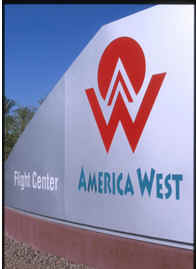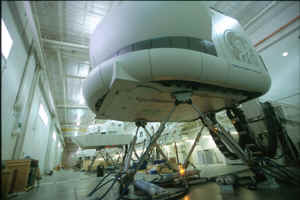AutomatedBuildings.com
Article - November 2002
[Home Page] |
[an error occurred while processing this directive]
(Click Message to Learn More) |
|
|

The project learning
curve was steep, and the road to success hard, requiring the cooperative efforts
of all the parties involved. In the end, though, the original vision was
realized, with a truly integrated HVAC System controlled and monitored through a
single front-end. |
Bill
Simpkins, Sales Manager
Building Technology Division
Climatec
Assisted by Bob
Kessler
and Don Calahan
Case Study
|
 The HVAC portion of the
America West Flight Simulator Building, in Phoenix, Arizona, was an innovative
and challenging project in which a truly Open Control System was put to a real
world test. We have all heard the sales pitches from the various manufacturers
about their system being "Open", with the ability to communicate with
other such "Open" systems on the market, but the time had now come to
put up or shut up.
The HVAC portion of the
America West Flight Simulator Building, in Phoenix, Arizona, was an innovative
and challenging project in which a truly Open Control System was put to a real
world test. We have all heard the sales pitches from the various manufacturers
about their system being "Open", with the ability to communicate with
other such "Open" systems on the market, but the time had now come to
put up or shut up.
The first step was
carefully selecting potential equipment and control vendors for the various
applications on the project: Computer Room Units, Chillers, Pumps, Air Handlers,
VAV Boxes, Variable Frequency Drives, Exhaust Fans, and Cooling Towers. The
equipment vendors had strict performance guidelines to match, and were required
to provide equipment that would communicate directly with the controls. This
sounds deceptively easy (Open Protocol is a concept that has been around for
years, with many pretenders to the throne of success), but in fact was not easy
since true Open communication between equipment and controls is actually quite
new. Smith Group's Engineer Jay Robins had the principal task of evaluating all
the potential equipment and control suppliers that would compete for the
Challenge/Privilege that was ahead of them. Once the design and selection
process was complete the Specifications and the plans went out for bid.
The equipment and
controls were chosen through the normal bidding process, with McQuay selected
for the Chillers and Air Handlers, Reliance for the Variable Frequency Drives,
Evapco for the Cooling Towers, Liebert for the Computer Room Air Conditioning,
and Honeywell for the Energy Management System (controls).
With any new protocol
(communication language) there is a risk involved and a learning curve
associated with that risk. Climatec Building Technology Group (BTG) made the
decision to step up to the plate and demonstrate that Open communication can
work, that it actually does have real world applications. At Climatec BTG we
have worked with various Open Protocols --- BACnet, LONWorks, Modbus, DDE,
TCP/IP --- but never with such a high level of real integration brought together
on one platform. With the help of Honeywell we incorporated Honeywell's new
SymmetrETM Building Management System to accomplish the task of integrating all
of the Open Protocols on the project into a single front-end solution.
The design of the
controls was based on taking all of the Open Protocols to the front-end with
integrating functions forming an Intelligent System. Through this Intelligent
System a vast amount of information is delivered to one central Operator
Workstation (OWS) Computer, creating a Facility Management Tool that greatly
enhances the Facilities Management Team's control and monitoring of their HVAC
system. An Echelon LONWorks communications backbone (utilizing LON routers
provided by Engenuity) connects the VAV Boxes, Air Handlers, Cooling Towers,
Pumps, and Exhaust Fans using LONWorks Open Protocol controllers. The Liebert
Computer Room Air Conditioning Units and the McQuay Chillers have on-board
controllers that use Modbus Open Protocol for communication. Both networks are
brought back to the Honeywell SymmetrETM front-end where the America West Flight
Simulator Facilities Managers are able to access their entire HVAC System.
[an error occurred while processing this directive]With the help of McQuay,
Real Time Automation (RTA), and Honeywell, and through many hours of testing in
the field, we were able to use the Modbus Open Protocol to control and monitor
the Chiller points. From the OWS the operator can view points (such as
evaporator pressures, temperatures, and current draws for the individual
compressors) internal to the building's dual-compressor McQuay Chillers. All of
these points are available over a two-wire network to the OWS for a fraction of
the cost of installing sensors in the field, and there is the added benefit of
having the point information at the OWS be the same as that seen at each
Chiller's on-board controller.
With the help of Reliance
and Honeywell --- and many more hours of testing --- we were also able to
control and monitor points internal to the Reliance Variable Frequency Drives
using the LONWorks Open Protocol technology. A total of 14 VFDs were installed
on the project to control motors on the Secondary Chilled Water Pumps, Cooling
Tower Fans, and Air Handler Supply and Return Fans. Through direct tie-ins to
the LONWorks communication bus, each VFD is integrated into a control sequence
over a network and shared with other controllers. Points include speed control,
demand limiting control, drive status and alarm, power factor, current draw, and
phase loss, as well as a variety of Energy Management features. Some of these
points and features were available in years past, but only through expensive PLC
controllers. At America West Flight Simulator the Secondary Chilled Water Pumps,
Cooling Tower Fans, and Air Handler Supply and Return Fans are all operated and
viewed over a simple pair of wires using Open Protocol.
Honeywell Excel 5000
LONWorks controllers automatically operate the VAV Boxes, Central Plant, Exhaust
Fans, and Air Handlers. The same pair of wires that are used to communicate with
the Reliance VFDs are also used to communicate with the 200+ VAV Boxes, and with
the Central Plant, Exhaust Fan, and Air Handler controllers throughout the
America West Flight Simulator Facility. Points internal to the individual
Honeywell controllers can be viewed and controlled at the OWS as well as
incorporated into Energy Management Strategies with other Open Protocol Devices.
 Cooling for the computers
at the actual Flight Simulators is supplied by Liebert CRAC Units, which are
automatically operated by Liebert's on-board controllers. In similar fashion to
the McQuay Chillers, the various points available at each Liebert CRAC Unit can
also be viewed at the OWS. The Facilities Managers can thus proactively respond
to problems before they have a chance to become full-blown crises.
Cooling for the computers
at the actual Flight Simulators is supplied by Liebert CRAC Units, which are
automatically operated by Liebert's on-board controllers. In similar fashion to
the McQuay Chillers, the various points available at each Liebert CRAC Unit can
also be viewed at the OWS. The Facilities Managers can thus proactively respond
to problems before they have a chance to become full-blown crises.
The project learning
curve was steep, and the road to success hard, requiring the cooperative efforts
of all the parties involved. In the end, though, the original vision was
realized, with a truly integrated HVAC System controlled and monitored through a
single front-end. The bottom line is that Open Systems are the way of the
future, and this project proved that they could be affordable and reliable.
Author - Bill Simpkins has
worked in the DDC industry for 15 years starting as the panel builder
and working up the ladder as a Designer/Cadd Operator, Engineer,
Sales and now Sales Manager.
[an error occurred while processing this directive]
[Click Banner To Learn More]
[Home Page] [The
Automator] [About] [Subscribe
] [Contact
Us]
 The HVAC portion of the
America West Flight Simulator Building, in Phoenix, Arizona, was an innovative
and challenging project in which a truly Open Control System was put to a real
world test. We have all heard the sales pitches from the various manufacturers
about their system being "Open", with the ability to communicate with
other such "Open" systems on the market, but the time had now come to
put up or shut up.
The HVAC portion of the
America West Flight Simulator Building, in Phoenix, Arizona, was an innovative
and challenging project in which a truly Open Control System was put to a real
world test. We have all heard the sales pitches from the various manufacturers
about their system being "Open", with the ability to communicate with
other such "Open" systems on the market, but the time had now come to
put up or shut up. Cooling for the computers
at the actual Flight Simulators is supplied by Liebert CRAC Units, which are
automatically operated by Liebert's on-board controllers. In similar fashion to
the McQuay Chillers, the various points available at each Liebert CRAC Unit can
also be viewed at the OWS. The Facilities Managers can thus proactively respond
to problems before they have a chance to become full-blown crises.
Cooling for the computers
at the actual Flight Simulators is supplied by Liebert CRAC Units, which are
automatically operated by Liebert's on-board controllers. In similar fashion to
the McQuay Chillers, the various points available at each Liebert CRAC Unit can
also be viewed at the OWS. The Facilities Managers can thus proactively respond
to problems before they have a chance to become full-blown crises.